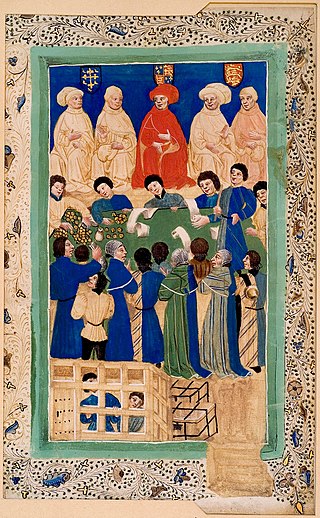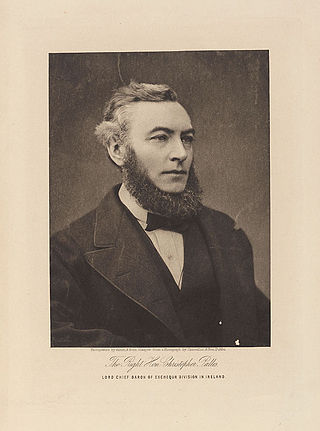
The Exchequer of Pleas, or Court of Exchequer, was a court that dealt with matters of equity, a set of legal principles based on natural law and common law in England and Wales. Originally part of the curia regis, or King's Council, the Exchequer of Pleas split from the curia in the 1190s to sit as an independent central court. The Court of Chancery's reputation for tardiness and expense resulted in much of its business transferring to the Exchequer. The Exchequer and Chancery, with similar jurisdictions, drew closer together over the years until an argument was made during the 19th century that having two seemingly identical courts was unnecessary. As a result, the Exchequer lost its equity jurisdiction. With the Judicature Acts, the Exchequer was formally dissolved as a judicial body by an Order in Council on 16 December 1880.

Christopher Palles was an Irish barrister, Solicitor-General, Attorney-General and a judge for over 40 years. His biographer, Vincent Thomas Hyginus Delany, described him as "the greatest of the Irish judges". He served as the last Lord Chief Baron of the Exchequer from 1874 until his retirement from the bench in 1916.

The Court of King's Bench was one of the senior courts of common law in Ireland. It was a mirror of the Court of King's Bench in England. The King's Bench was one of the "Four Courts" which sat in the building in Dublin which is still known as "The Four Courts", and is still in use.
Stephen Woulfe was an Irish barrister and Whig politician. He served as Solicitor-General for Ireland in 1836 and as Attorney-General for Ireland in 1838. He was the first Roman Catholic to be appointed Chief Baron of the Irish Exchequer. He died young, due to a combination of chronic ill-health and overwork.

The Exchequer of Ireland was a body in the Kingdom of Ireland tasked with collecting royal revenue. Modelled on the English Exchequer, it was created in 1210 after King John of England applied English law and legal structure to his Lordship of Ireland. The Exchequer was divided into two parts; the Superior Exchequer, which acted as a court of equity and revenue in a way similar to the English Exchequer of Pleas, and the Inferior Exchequer, which directly collected revenue from those who owed The Crown money, principally rents for Crown lands. The Exchequer primarily worked in a way similar to the English legal system, holding a similar jurisdiction. Following the Act of Union 1800, which incorporated Ireland into the United Kingdom, the Exchequer was merged with the English Exchequer in 1817 and ceased to function as an independent body, although the Irish Court of Exchequer, like other Irish courts, remained separate from the English equivalent.

The Chief Baron of the Irish Exchequer was the Baron (judge) who presided over the Irish Court of Exchequer. This was a mirror of the equivalent court in England, and was one of the four courts which sat in the building in Dublin which is still called The Four Courts.
Sir Richard Ryves (1643–1693) was a seventeenth-century Irish judge who served for several years as Recorder of Dublin, and subsequently as a Baron of the Exchequer. He was briefly a Commissioner of the Great Seal.

The Court of Common Pleas was one of the principal courts of common law in Ireland. It was a mirror image of the equivalent court in England. Common Pleas was one of the four courts of justice which gave the Four Courts in Dublin, which is still in use as a courthouse, its name. Its remit as in England was to hear lawsuits between ordinary citizens.
Sir Robert Bagod was an Irish judge who was appointed the first Chief Justice of the Irish Common Pleas in 1276. He built Baggotrath Castle, which was the strongest fortress in Dublin: it was located on present-day Baggot Street in central Dublin. He also founded the Carmelite Friary in Dublin.

William Tynbegh, or de Thinbegh (c.1370-1424) was an Irish lawyer who had a long and distinguished career as a judge, holding office as Chief Justice of all three of the courts of common law and as Lord High Treasurer of Ireland. His career is unusual both for the exceptionally young age at which he became a judge, and because left the Bench to become Attorney General for Ireland, but later returned to judicial office.
Robert de Holywood was an Irish judge and landowner who held the office of Chief Baron of the Irish Exchequer. He was the ancestor of the Holywood family of Artane Castle, and of the St. Lawrence family, Earls of Howth. He was a substantial landowner with property in Dublin, Meath and Louth. He became extremely unpopular, and was removed from office after numerous complaints of "oppression and extortion" were made against him. These were apparently inspired ĺargely by his close association in the mid-1370s with Sir William de Windsor, the embattled Lord Lieutenant of Ireland.
Henry Mitchell (c.1320–1384) was an Irish judge of the fourteenth century. He was one of the first recorded holders of the office of Attorney General for Ireland, and was subsequently Chief Baron of the Irish Exchequer and Chief Justice of the Irish Common Pleas.
Sir John de Shriggeley, whose family name is also spelt Shirggeley and Shryggeley was an Irish statesman and judge who held several important judicial offices, including Chief Justice of the Irish Common Pleas. Although he committed two murders, he was a valued servant of the English Crown.
John Bermyngham or Bermingham was an Irish barrister and judge. He was one of the first Crown Law officers to be referred to as the King's Serjeant. He was later appointed Lord Chief Justice of Ireland, but did not take up the office.
John Tirel, or Tyrell was a prominent judge and statesman in fourteenth-century Ireland who held office as Serjeant-at-law and Chief Justice of the Irish Common Pleas.

Thomas Bache was an Anglo-Italian cleric and judge who held high office in Ireland in the later fourteenth and early fifteenth centuries. He served one term as Lord High Treasurer of Ireland and three terms as Chief Baron of the Irish Exchequer.
Thomas Snetterby was an Irish barrister, King's Serjeant and Crown official of the fifteenth century. He was remembered long after his death for giving his name to Snetterby's orchard near Kevin Street, Dublin.
William Hilton was an Irish politician, barrister and judge. He is now mainly remembered for his family connection to James Ussher, Archbishop of Armagh, whose sister Anne he married, and who furthered his career.
John Gough, or John Gogh was an Irish barrister, judge and Crown official of the fifteenth century.

John Brettan or Breton was an Irish judge and Crown official. His petitions to the Irish Privy Council, of which he wrote five between 1376 and 1382, and which have survived ; cast a valuable light on the disturbed condition of English-ruled Ireland in the late fourteenth century, and especially the situation in Carlow, his home town, which was the effective seat of English government in the latter half of the fourteenth century.







